Vallisneria americana (American Eelgrass)
| Also known as: | Water Celery, Wild Celery, Tape-grass |
|---|---|
| Genus: | Vallisneria |
| Family: | Hydrocharitaceae (Frog's-bit) |
| Life cycle: | perennial |
| Origin: | native |
| Habitat: | part shade, sun; shallow to 10+ feet deep, calm or slow-moving water; lakes, ponds, rivers, streams |
| Bloom season: | July - September |
| Plant height: | to 6 feet |
| Wetland Indicator Status: | GP: OBL MW: OBL NCNE: OBL |
| MN county distribution (click map to enlarge): |  |
| National distribution (click map to enlarge): |  |
Pick an image for a larger view. See the glossary for icon descriptions.
Detailed Information
Flower: 

![[photo of female flower]](/udata/r9ndp23q/pd3/vallisneria-americana-081816-12-t.jpg) Separate male and female flowers are on different plants (dioecious). Female flowers are single at the tip of a long, naked stalk, lack petals and have 3 sepals each about 4 mm (1/6 inch) long. In the center are 3 broad, white, 2-parted styles. Between the flower and stalk is a green to whitish, tubular sheath (spathe). The flower stalk is initially straight and elongates until it reaches the water's surface, where the flower opens and floats on the surface waiting for pollination, after which the stalk starts coiling, usually dragging the developing fruit under water.
Separate male and female flowers are on different plants (dioecious). Female flowers are single at the tip of a long, naked stalk, lack petals and have 3 sepals each about 4 mm (1/6 inch) long. In the center are 3 broad, white, 2-parted styles. Between the flower and stalk is a green to whitish, tubular sheath (spathe). The flower stalk is initially straight and elongates until it reaches the water's surface, where the flower opens and floats on the surface waiting for pollination, after which the stalk starts coiling, usually dragging the developing fruit under water.
![[photo of male flowers on a female flower]](/udata/r9ndp23q/pd3/vallisneria-americana-081517-17-t.jpg) Male flowers are enclosed within an egg-shaped, leaf-like sheath (spathe) at the tip of a short stalk. The spathe detaches from the stalk and floats to the water's surface, where it opens, exposing the stamens, and acts like a boat, drifting across the water's surface where it may get lucky and bump into an open female flower.
Male flowers are enclosed within an egg-shaped, leaf-like sheath (spathe) at the tip of a short stalk. The spathe detaches from the stalk and floats to the water's surface, where it opens, exposing the stamens, and acts like a boat, drifting across the water's surface where it may get lucky and bump into an open female flower.
Leaves and stems: 

![[photo of basal leaf clump]](/udata/r9ndp23q/pd3/vallisneria-americana-081517-2-t.jpg) Leaves are all basal, submersed or sometimes partially floating, stalkless, linear, flat, thin, 4 inches to 6+ feet long depending on water depth, 3 to 15 mm (to ~½ inch) wide, rounded to pointed at the tip, grading into a sheath at the base. Edges are toothless to minutely toothed and may be crinkly/wavy.
Leaves are all basal, submersed or sometimes partially floating, stalkless, linear, flat, thin, 4 inches to 6+ feet long depending on water depth, 3 to 15 mm (to ~½ inch) wide, rounded to pointed at the tip, grading into a sheath at the base. Edges are toothless to minutely toothed and may be crinkly/wavy.
![[photo of lacunar bands on 3-striped leaves]](/udata/r9ndp23q/pd3/vallisneria-americana-151-1-t.jpg) Color is green to red, with a central band around the midvein that is lighter colored than along the edges, giving a 3-striped appearance. The central band is known as the lacunar band, made up of several rows of large, hollow cells. Flowering stems are usually multiple from the base. Plants form colonies from horizontal stems, both above ground (stolons) and underground (rhizomes).
Color is green to red, with a central band around the midvein that is lighter colored than along the edges, giving a 3-striped appearance. The central band is known as the lacunar band, made up of several rows of large, hollow cells. Flowering stems are usually multiple from the base. Plants form colonies from horizontal stems, both above ground (stolons) and underground (rhizomes).
Fruit: 
![[photo of developing fruit]](/udata/r9ndp23q/pd3/vallisneria-americana-83012-3-t.jpg) Fruit is a cylindric capsule 2 to 4¾ inches long, somewhat resembling a string bean. Inside are numerous seeds.
Fruit is a cylindric capsule 2 to 4¾ inches long, somewhat resembling a string bean. Inside are numerous seeds.
Notes:
Eelgrass is an important species for wildlife, providing food and shelter for waterfowl, shore birds, fish, and muskrats. It is typically found in the shallow, calm waters of lakes with sandy or mucky bottoms, less often in deeper waters, steadily flowing streams and rivers, brackish water, or in marly or silty soil. It primarily reproduces vegetatively, which is probably a good thing since its pollination process seems more or less a hit or miss operation. The coiling stems of female flowers are easily recognizable, and the 3-striped appearance of leaves can distinguish it from other species with basal clumps of ribbon-like leaves.
Native Plant Nurseries, Restoration and Landscaping Services ↓
More photos
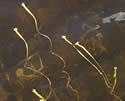 American Eelgrass plants
American Eelgrass plants American Eelgrass plants
American Eelgrass plants submersed plant
submersed plant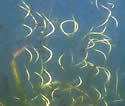 submersed plants
submersed plants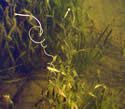 submersed, mostly vegetative, plants
submersed, mostly vegetative, plants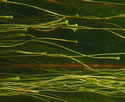 flowering stems in flowing water
flowering stems in flowing water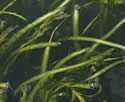 leaves are green to reddish
leaves are green to reddish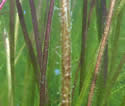 leaves can grow to 6+ feet long
leaves can grow to 6+ feet long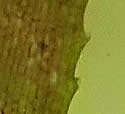 leaf edges are toothless to minutely toothed
leaf edges are toothless to minutely toothed
Photos by Peter M. Dziuk taken in Anoka, Carlton, Cass, Cook, Douglas and Itasca counties.
Comments
Have you seen this plant in Minnesota, or have any other comments about it?






